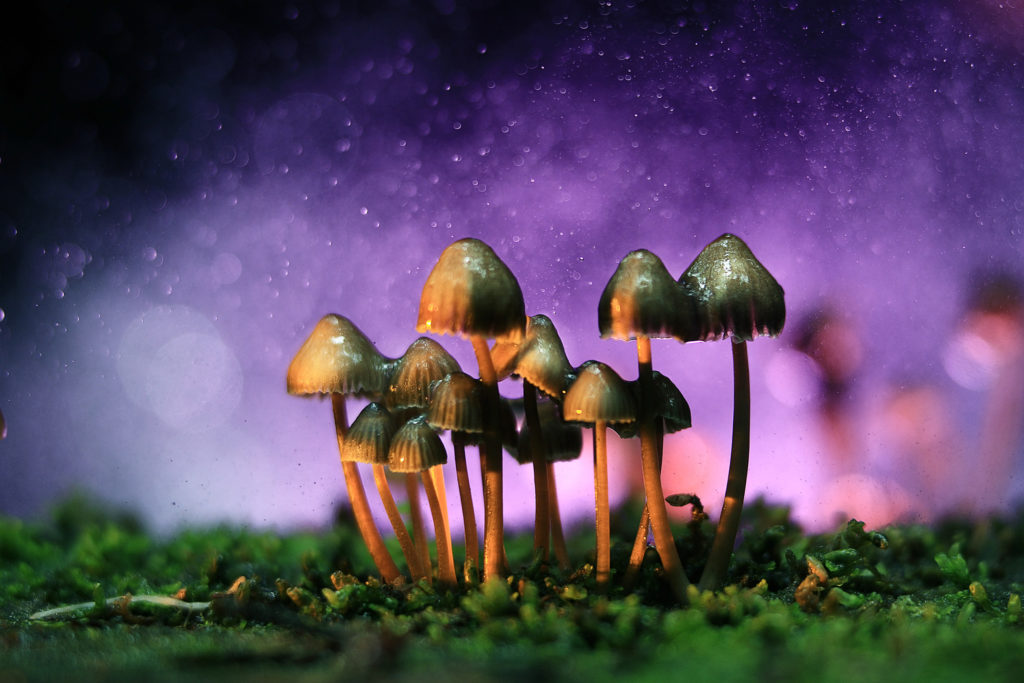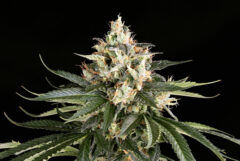Cannabis has been used by humans for thousands of years, so it comes as no surprise that some theorize that the two coevolved together. Fundamentally, the way that cannabis affects the human brain may have played a role in brain efficiency and effectively, the structure of society as a whole.
Since the counter-culture explosion of the 1960’s, a small but persistent school of thought has expounded the theory that as humans evolved, their use of entheogenic drugs assisted in the development of social constructs such as ritual, language and music. Effectively, some believe, use of psychoactive drugs altered the course of human evolution, and assisted our meteoric rise to global dominance.
Did hallucinogenic mushrooms assist human evolution?
This topic has long inspired fascination among social anthropologists, many of whom have written on the subject at great length. Food of the Gods by Terrence Mckenna is one such example that postulated that hallucinogenic mushrooms coevolved with early nomadic herding communities.
These communities are thought to have achieved greater visual acuity when hunting, as well as heightened enthusiasm for social ritual (possibly including fertility rites), thereby strengthening and increasing the population.
While these early nomadic herders enjoyed the benefits offered by the hallucinogenic mushrooms (usually found growing in cattle dung), they in turn safeguarded the other species’ existence by cultivating and protecting it, providing scope for future mutations favourable to the human population to be positively selected for and made dominant.

Simultaneously, the benefits afforded the early hunter-gatherers were so great that subsequent human generations were more advantaged if they could respond more precisely to the psychological effects of the drug.
Ultimately, in both species, positive selection of mutually-beneficial traits led to long-term coevolution. The increasing importance of cattle ensured a constant supply of dung, and therefore an abundant supply of mushrooms, so it is hard to ascertain whether use of mushrooms was incidental or central to these emerging cultures. However, even if one species was of lesser overall importance, this relationship could be an example of a three-species system of coevolution.
Coevolution between cannabis and humans
Similarly to mushrooms, cannabis had several benefits to offer the early communities that first encountered it, which may even have been as early as 27,000 BP. Not only did it provide fibre and seed, it also quickly demonstrated its usefulness in the early pharmacopoeia, and it is very likely that its psychoactive effects were utilised in religious practice from very early on (although the first direct evidence of cannabis as a pharmacological agent is thought to date from 2,700 BP).

Social use of cannabis has been shown to strengthen interpersonal relationships, increasing feelings of cohesion and trust.
In the brain, cannabinoid receptors are found in many areas, and assist in a range of functions from basic mobility to comprehension of language and perception of emotions. While much of the most striking evolution of the human brain is thought to have occurred during the Great Leap Forward of around 60,000 BP, much of the “fine-tuning” of language capability, as well as several fundamental changes to the structure of the neocortex and cerebellum, occurred over the last 10,000 years.
Evolution of the brain during the post-glacial Holocene epoch
Interestingly, this was also around the time of humanity’s switch to agrarian communities, and may have occurred simultaneously with a 10% reduction in brain size. Rather than pointing to a decline in human intelligence, this reduction may imply an increase in the efficiency of the brain, or a reduction in energy requirements due to the relative peace of settled communities. Whatever the cause, this reduction and restructuring marked a significant shift in the development of human society.
During the Holocene epoch (c. 11,700 BP to present), the human cerebellum grew larger and the cerebral cortex reduced in size compared to our immediate ancestors. The cerebellum has many reciprocal links to the neocortex and is crucial to various functions, from basic motor skills to highly developed cognitive faculties.
It is thought that its increased size may assist modern humans in processing increasingly complex cultural and visual stimuli. Significantly, the cerebellum is thought to be crucial to modern humans’ appreciation of music, as well as to our use of ritual, increase in behavioural complexity, and ability to utilise tools.
The importance of music in the evolution of society
The link between our evolution of musical sensibility and cannabis may be quite fundamental to an overall understanding of how our consciousness has been shaped by the drug. In fact, it could be argued that music is central to the evolution of human consciousness.
Music has enabled humanity to reach greater depths of cohesion, and has been widely utilized to engender an emotional response in listeners: church music to inspire religious devotion and holy awe; war chants to intimidate the enemy and create feelings of solidarity and shared strength; romantic music to increase arousal and intensity of sexual interactions.
Research has shown that the social influence of music and the listener’s enjoyment can be altered by consumption of cannabis, and of course, the social link between cannabis and musical genres such as jazz and reggae is universally known.
The brain’s normal response to music is itself complicated. The cerebellum recognises and “enjoys” the basic timing or rhythm, and the frontal lobes respond to language, in the form of lyrics. Within the temporal lobes, the primary auditory cortex converts waveforms into our perception of pitch, while the amygdala undergoes a deep emotional response and retains memories of familiar tunes. Musical response also manifests in the occipital and parietal lobes; therefore each lobe of the cerebral cortex is activated to varying degrees (possibly according to the type of music).
How cannabis alters perception of music
The effects of cannabis on the human experience of music are so complex that it is hard to determine their exact nature. However, previous research has suggested that the evolution of more specialised cannabinoid signalling systems strengthened the synaptic connections from the cerebellum to the various parts of the cerebral cortex. Under the influence of cannabis, the regions of the brain affected when listening to music all experience an altered response.

Use of cannabis has been shown to alter one’s temporal perception by speeding up the “internal clock” of the cerebellum, resulting in a sensation of “stretched” or dilated time. When listening to music, this can increase awareness and appreciation of complex structure.
Heightened perception of lower frequencies adds to the richness of perceived sounds, and improves the timbre of one’s own voice; this effect occurs within the auditory cortex. Cannabis consumption causes increased activity in the frontal lobes, which can heighten comprehension and response to lyrics. When activity is increased in the parietal lobes, attentiveness and concentration can improve.
Our knowledge of the evolutionary processes leading to our current highly complex state of existence is patchy at best. However, it is likely that selection of genes favourable to a heightened appreciation of music would be beneficial to emerging societies, given how important the music-processing faculties are to communication and social interaction as a whole.
Likewise, we would be likely to select cannabis varieties that would increase our appreciation of music. Over the last 10,000 or so years, the rate at which both species have expressed new genes has been remarkably high, increasing the likelihood of mutually-beneficial selection occurring, and it is reasonable to believe that this coevolution will persist long into the future.
- Disclaimer:Laws and regulations regarding cannabis use differ from country to country. Sensi Seeds therefore strongly advises you to check your local laws and regulations. Do not act in conflict with the law.











this is a great blog.I came across your blog and I read your blog and this is a great blog.Please keep up posting such blogs.
Very interesting !
Thsi is one of the most interesting articles I have read about the subject of Human-Cannabis coevolution. It makes a lot of sense. In fact, As a Marine Biologist one of my main interest has been to understand why there a virtually no substances that cause hallutinations in the sea (except for some toxins that are not really entheogens such as those found in puffer fish and the algae Caulerpa ssp.). However, there are plenty in land, and most have been tried by humans already. So… reading this artile confirms my believe that most entheogens have to do directly with the evolution humans, which are mainly LAND animals and are the one species thta can really (for now) apprecciate their effects. A text book case of co-evolution. Thanks for the compendium of data… Seshata. Cheers.
Happy to help, and thanks for the feedback! 🙂